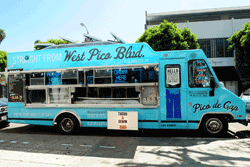Younger, trendsetting consumers purchasing expensive designer jeans may not have identified with the Gap’s 1969 line, but the brand was out to change all that with a surprise and delight approach.
 Inspired by a taco truck in one of the brand’s recent ad campaigns and the fact that its 1969 design studio is located on Pico Blvd. in Los Angeles, it came up with “Pico de Gap” —a fusion of food and fashion served up simultaneously in four major markets—Los Angeles, San Francisco, Chicago and New York—during the summer of 2011.
Inspired by a taco truck in one of the brand’s recent ad campaigns and the fact that its 1969 design studio is located on Pico Blvd. in Los Angeles, it came up with “Pico de Gap” —a fusion of food and fashion served up simultaneously in four major markets—Los Angeles, San Francisco, Chicago and New York—during the summer of 2011.
The trucks were decorated with colorful neon signs, bold black copy and brand-specific touches like custom grill letters (GAP replaced GMC on the hood) and rolled 1969 denim displayed above ice cold Mexican sodas. Tacos were served by celebrity chefs Marcel Vigneron (LA) and Ryan Scott (SF) of “Top Chef” fame, Rich Gresh of David Burke’s Primehouse (Chicago) and best-selling author Katie Lee (New York).
The menus were combined with offers of two tacos, a drink and a $20 coupon for Gap 1969 denim, all for the price of $1.69. In every market, tacos sold out daily and frequently within an hour of opening. For a lucky few, “golden tickets,” good for a free pair of jeans, were awarded through random selection or daily Twitter contests.
“Pico de Gap” was promoted throughout both traditional and social channels. The celebrity chefs featured the truck on cooking demos on shows such as Extra and Good Day LA. There were print interviews with key Gap executives and photo galleries on respected fashion blogs all prior to the truck’s arrival in each city. The taco truck was also featured on Gap’s Facebook page, while each market had its own Twitter handle. Both online platforms disseminated location and other information, as well as facilitating two-way conversations with customers.
“Pico de Gap” held 100 events in four cities in just under 60 days and delivered a sales lift in every market. More than 51,000 tacos were sold; 25,000 bounce-back coupons were distributed; 1,000 “Free Jeans” certificates were awarded; more than 3,000 new Twitter followers were gained; nearly 25 million social medial impressions were generated between Facebook and Twitter; and roughly 276 million earned media impressions were generated across broadcast, print and online, exceeding the paid media reach.
 Network
Network

